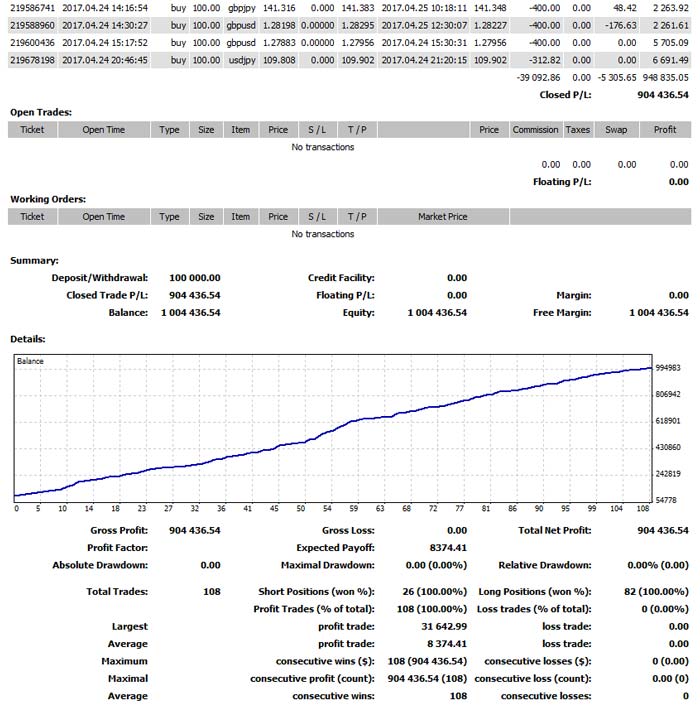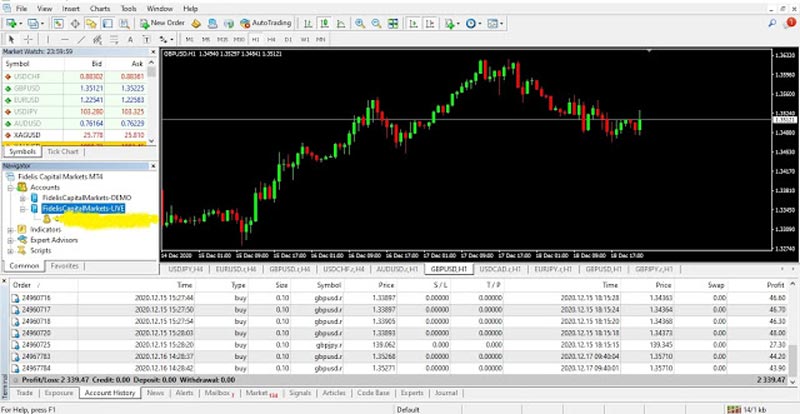What you are about to read:
In forex trading, a Forex statement refers to the accurate record of all trading activities and transactions executed in a specific trading account over a defined period. This article from Brokerland discusses this statement as a comprehensive summary of account performance, including profits, losses, executed trades, and various other metrics related to trading activity. A Forex trading statement in forex is a vital tool for traders to assess their trading performance, track progress towards financial goals, and make informed decisions about their trading strategies.
What is a Forex Statement?
A Forex trading statement in forex is a summary of a trader’s trading activities over a specific period, usually provided by a forex brokers trading platform or third-party analytical tools. This statement includes essential information such as the trader’s equity and balance, profits, losses, and an accurate record of all trades executed within a specified time frame.
A Forex statement serves as a valuable tool for traders to evaluate their performance, track progress towards financial goals, analyze trading strategies, and identify areas for improvement. Similar to a trading journal, it provides transparency and accountability by documenting all trading activities, enabling traders to make informed decisions and adjust their approach. The key components of a forex trading statement are as follows:
Trade History: Forex statement typically includes a detailed history of all trades executed during the specified period. This includes information such as the date and time of each trade, the currency pair traded, position size (lot size), entry and exit prices, and whether the trade resulted in a profit or loss.
Profit and Loss Summary (P&L): The P&L summary provides an overview of account profitability during the reporting period. This includes metrics such as total profit, total loss, net profit or loss, and return on investment (ROI) percentage or percentage change in account balance.
Balance and Equity: The Forex trading statement displays the account balance, final account equity, and any changes in equity resulting from trading activities, including profits, losses, deposits, and withdrawals.
Open Positions: For active trades that have not yet been closed, the Forex statement may list details of open positions, including current market prices, unrealized profits or losses, and margin requirements.
Trading Costs: Transaction costs incurred during trades, such as spread, commissions, and swap fees, are usually documented within the statement to provide a comprehensive view of trading expenses. These values can vary between brokers; for example, broker fees at Fibo group may differ from those at USGFX, and each broker typically lists these fees on their website.
Drawdown Analysis: Drawdown refers to the reduction from peak to trough of the account balance during a specific period. A Forex statement may include an analysis of these values.
Risk Management Metrics: Some statements may incorporate risk management metrics such as risk to reward ratio and average profit per trade to evaluate the effectiveness of a trader’s risk management strategies.
Importance of Forex Trading Statements
Having a Forex statement is highly important in forex trading. The reasons for this importance are outlined below:
- Performance Evaluation: It allows forex traders to objectively evaluate their trading performance. By examining key metrics such as profits, losses, and return on investment (ROI), traders can identify strengths and weaknesses in their trading strategies and make adjustments accordingly.
- Progress Tracking: Similar to a MetaTrader strategy tester, a Forex trading statement helps traders track their progress towards their trading goals and objectives. By comparing current performance with past performance, traders can assess whether they are on track to reach their goals and adjust their strategies if necessary.
- Pattern and Trend Identification: Analyzing a Forex statement can reveal patterns and trends in trading behavior and market conditions. Traders can use this information to capitalize on profitable opportunities and avoid repeating past mistakes driven by emotions and FOMO.
- Improved Decision Making: With accurate trading data and performance metrics, traders can make more informed decisions regarding trade entries, exits, position sizing, and risk management.
In summary, Forex trading statements are essential tools for forex traders to evaluate their trading performance, track progress towards goals, and make informed decisions about their trading strategies. By maintaining accurate and detailed trading records, traders can increase their chances of success in the forex market.
How to Obtain Your Forex Trading Statement?
To obtain a Forex statement, you typically need access to your trading account through the online trading platform or software provided by your chosen forex broker. Here is a step-by-step guide on how to obtain Forex statement:
- Access Your Trading Account: Log in to your forex trading account using your username and password. This can usually be done through the broker’s website or via trading software provided by the broker.
- Find Trade History or Account Statement Section: Once logged in, navigate to a section of the trading platform where you can access your trade history or account statements. This section may be labeled differently depending on the broker but is usually found under tabs such as “Account History,” “Trade History,” or “Account Statements.”
- Select a Time Period: Choose the time period for which you want to generate the Forex statement.
- Generate the Statement: After selecting your desired time frame, click on the option to generate or download the Forex trading statement. Depending on the broker’s platform, you may have the option to view the statement directly on the platform or download it in a printable or downloadable format such as PDF or Excel.
- Review the Forex Statement: Once the statement is generated, carefully review it to ensure that all trades and details are accurately recorded. Check details such as trade dates, currency pairs traded, position sizes, entry and exit prices, profits, losses, transaction costs, and any other relevant information.
- Save or Print: After reviewing the statement, you can choose to save it for your records or print a hard copy if needed. This allows you to maintain a record of your trading activity for analysis and future reference.
- Optional: Analyze Trading Data. If you’re interested in further analyzing your trading performance, you can use the data from the Forex statement to calculate metrics such as profit and loss, ROI, drawdown, win-loss ratio, and other performance indicators. This analysis can help you identify areas for improving your trading strategies and decision-making processes.
- Repeat as Needed: You can regularly generate Forex trading statements to track your trading performance over time and monitor your progress towards your trading goals. Some brokers may also offer automated options for receiving regular statements via email or through their online platform.
By following these steps, you can easily obtain a trading portfolio in forex and gain valuable insights into your trading activities and performance. Regular examination and analysis of this can help you make informed decisions and improve your trading skills over time.
Platforms and software for creating trading statements
There are various platforms and tools available that can assist you in creating trading portfolios in forex. These platforms are often offered by forex brokers or third-party service providers and provide features for tracking and analyzing your trading activities. Here are a few popular platforms and tools that you can use to create forex trading statements:
Platforms provided by brokers: Most forex brokers offer their own trading platforms, often including features for generating Forex trading statements. These platforms typically provide access to market data, charting tools, and transaction history reports. Examples of popular trading platforms offered by brokers include MetaTrader 4 (MT4), MetaTrader 5 (MT5), cTrader, and proprietary platforms developed by specific brokers.
MetaTrader 4 (MT4) and MetaTrader 5 (MT5): MT4 and MT5 are widely used trading platforms in the forex market known for their user-friendly interface and comprehensive features. Both platforms allow traders to generate detailed Forex statements that include trade history, balance, equity, profit and loss, and other relevant metrics. Traders can customize the time period for which they want to generate the portfolio and export it in various formats such as HTML, CSV, or Excel.
Forex trading journals and Excel sheets: Some traders prefer to maintain their journals or Excel sheets to track their trading activities and create forex statement. These journals or extensive sheets can be created using software like Microsoft Excel or Google Sheets and customized to include specific data fields and performance metrics relevant to the trader’s needs. Additionally, pre-designed templates for forex trading journals are available online, which traders can use to simplify the process.
Third-party analytical tools: Several third-party analytical tools and trading software are available that provide advanced features for analyzing trading data and generating portfolios. These tools may offer additional functionalities such as performance analysis, risk management tools, trade analysis, and other tools. Examples of third-party analytical tools include MyFxBook, TradingView, and Forex Tester.
Broker reports and statements: Many forex brokers provide regular reports and forex statement to their clients summarizing their trading activities and performance. These reports may include monthly or quarterly statements, account summaries, and other documents and explanations. Traders can usually access these reports through their broker’s online portal or trading platform.
When selecting a platform or tool to create forex trading statement, consider factors such as ease of use, customization options, analytical features, and compatibility with your trading strategy and workflow. Choosing a platform that meets your specific needs and preferences for effectively tracking and analyzing your trading activities is essential.
Summary
Understanding and interpreting forex statement is crucial for traders seeking success in the dynamic world of currency exchange. These portfolios serve as comprehensive snapshots of a trader’s performance and encompass important metrics such as profit, loss, leverage, margin, and exposure to risk. Through detailed analysis of these Forex statements, traders can identify patterns, evaluate the effectiveness of their strategies, and make informed decisions to optimize their trading approach.
Additionally, Forex trading statements provide valuable insights into risk management practices, enabling traders to mitigate potential losses and capitalize on profitable investment opportunities, thereby enhancing long-term stability and growth in the forex market. This forex learning article has covered how to prepare these portfolios in trading and platforms and sites that assist you in doing so, ensuring that you always adhere to this critical principle in forex and trading success.











